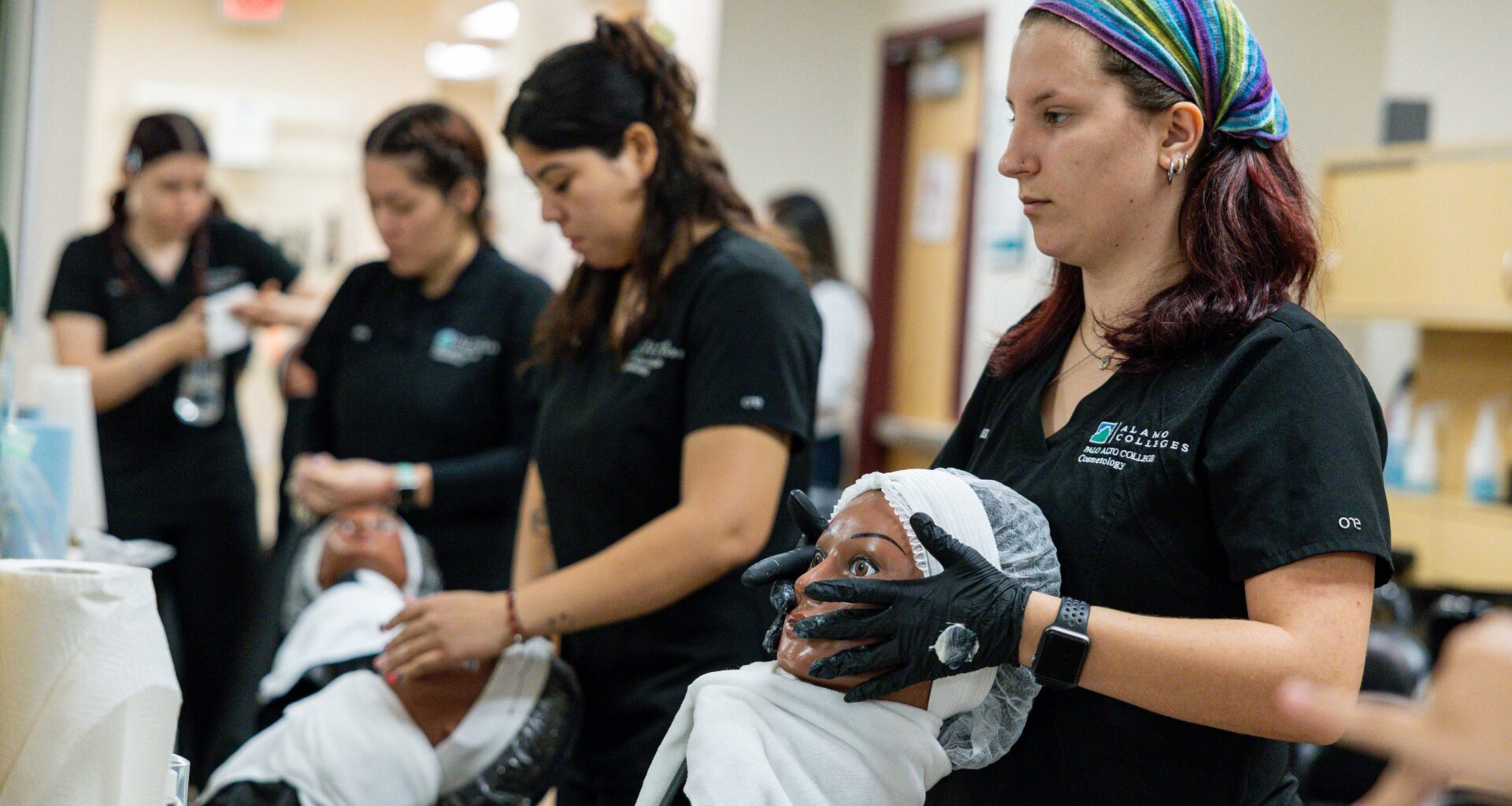As the allotted eight minutes quickly passed, Olivia Meza focused on her mannequin as she carefully performed each step of a facial in front of her instructors; cleansing, massaging, exfoliating, moisturizing, don’t lose contact with the client and never forget to sanitize your hands in between steps.
This was part of the midterm exams at Palo Alto College’s cosmetology operator program, the only one of its kind in San Antonio.
The sanitizing part actually comes in handy when it’s hard to remember what comes next, Meza said, it gives her a second to reset.
“You have to make sure you are doing the steps in the right order. If you do them out of order that’s a point loss,” she said. “It’s just nerve-wracking. … But I’m feeling confident just because we’re going over it every time in class, so it’s like muscle memory, basically.”
Meza, 22, is one of 17 students in the program who are about to complete the 1,000 hours required to take a licensing exam through the Texas Department of Licensing and Regulation in order to work in the field.
As the only public community college offering these courses in the San Antonio region, Palo Alto has grown the program since it began in 2015. Tuition here costs thousands of dollars less than for-profit cosmetology schools in the area with big names attached, like Aveda, Milan and Paul Mitchell, which can cost anywhere between $16,000 to $22,000 for an eight- to twelve-week program.
For Meza, cost was definitely an important factor: she works at a boba shop part-time to pay for her expenses and college tuition — which totals about about $6,500. She was able to get on a payment plan, she said, paying about $400 per month to graduate debt-free in two years.
“Beauty school tends to be so expensive,” Meza said. “I pay for my college for myself, so [I like] being able to have a payment plan … I don’t have any financial aid.”
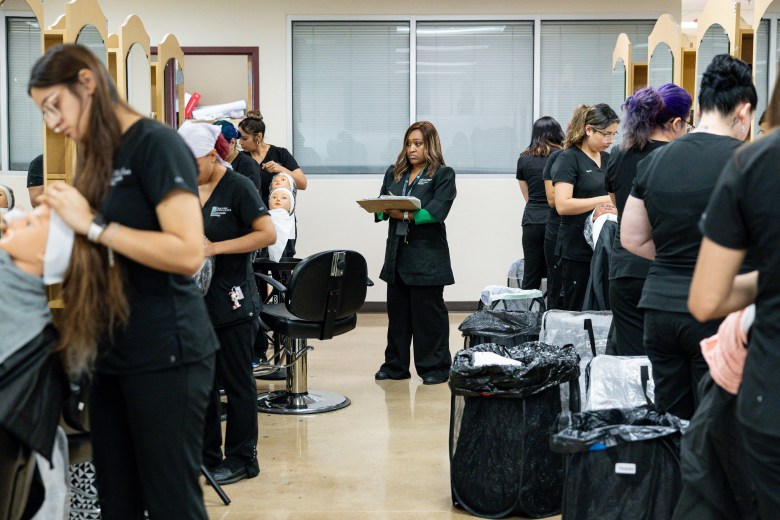 Lead Cosmetology Instructor Jasmine Hillyer surveys students during a practice exam in the Palo Alto College Cosmetology Learning Studio on Monday, Oct. 20, 2025. Credit: Amber Esparza / San Antonio Report
Lead Cosmetology Instructor Jasmine Hillyer surveys students during a practice exam in the Palo Alto College Cosmetology Learning Studio on Monday, Oct. 20, 2025. Credit: Amber Esparza / San Antonio Report
According to trade school data released by The Hechinger Report, private cosmetology school graduates in San Antonio reported earning between $12,000 and $22,500 annually four years after completing the program, a lot less than the average high school graduate earnings of about $31,000.
However, Palo Alto’s Cosmetology Program Director Lydia Hannawi said this is the kind of field in which licensed professionals can more or less money, based on the amount of hours they work, which specializations they have and more.
“I tell [students] to think outside the box,” Hannawi said. “There are opportunities to continue and get a business degree and then you can think more globally. You can get a position at Revlon or Estée Lauder.”
The college advertises the average income of a licensed cosmetology operator at an average of $16.87 per hour, meaning a full-time worker with this license could earn about $35,000 per year. The esthetics pathway is advertised as having an average hourly rate of about $21, or $43,700 annually.
Palo Alto’s program started in 2015 with the cosmetology operator track. Two years later it added the esthetician track, and in 2024 the college started offering a nail technician track.
The programs grew mainly due to word of mouth, Hannawi said, as students spread the word of an affordable option in the region. She now accepts about 64 students each year for the cosmetology operator track and about 36 for the esthetician track.
“We started with a small cohort of 10 students,” she said. “Currently, I have three cohorts, two during the day and one in the evening. It’s grown exponentially.”
Finding low-cost options
At Palo Alto, tuition ranges between $4,250 and $6,500 for Bexar County students depending on whether they’re getting a certificate or the associate degree. The cost for students who live outside Bexar County is between $7,000 and $11,000.
Alamo Promise also offers local students a tuition-free option through a combination of grants and scholarships.
Students in both the cosmetology and esthetician tracks also have the option to take a handful more courses to earn an associate degree of applied science. This two-year program includes business management and marketing classes.
“The associate degree will have a few courses where we introduce them to business principles,” she said. “They’ll take a business course, they’ll take a marketing course so that when they graduate and if the goal is to go into business on their own, then they have the knowledge so that they can become successful.”
Students can choose to go the more traditional route and become hairstylists, nail technicians, salon educators or owners. They can also go the esthetician route and specialize in skin care, eyelash extensions, makeup artistry and more.
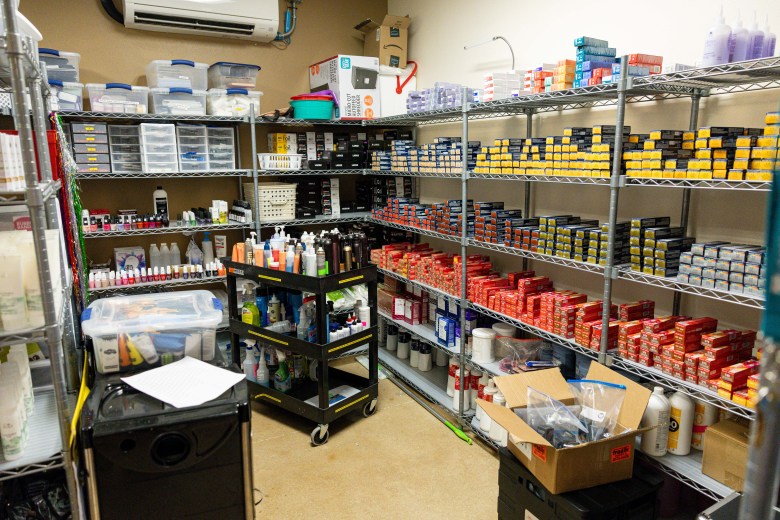 The Palo Alto College cosmetology storage room is stocked with a range of beauty and care products from hair dye and extensions to nail supplies and dermatology products. Credit: Amber Esparza / San Antonio Report
The Palo Alto College cosmetology storage room is stocked with a range of beauty and care products from hair dye and extensions to nail supplies and dermatology products. Credit: Amber Esparza / San Antonio Report
“There’s a tremendous interest in the esthetician program,” Hannawi said. “There are young ladies, and some young men, that are interested in working for spas, having their own suites, learning all about skin care treatments.”
While cosmetology operators need to complete 1,000 hours and take the state test, the esthetician route requires 750 hours.
Students also pay for their own equipment, or kit, which includes basics such as a mannequin head, shears and clippers. The kits could cost anywhere from $500 to $2,000, but Hannawi said they break down the requested materials per module to lessen the up-front cost for students.
Student demand has remained steady over the last few years, Hannawi said, adding that like most other programs, cosmetology also experienced a decline during the coronavirus pandemic.
During a recent open house, Hannawi said they expected to have about 20 to 30 students touring their facilities — which include a hair salon, an esthetician’s room and a nail classroom — but they instead received about 80 students.
Due to the program’s low cost and degree tracks, she believes interest will continue to increase. But she can only admit between 12 and 22 students at a time for the different tracks, as the hands-on program requires small classes.
“Right now we are working on the curriculum to start a barber program sometime in the near future,” Hannawi said. “I’m maxed out during the day. So the goal is to start it as an evening class.”
A high school-to-workforce pipeline
Some local students can get started in cosmetology even earlier.
Some of San Antonio’s public school districts have offered free or low-cost cosmetology pathways for high school students. San Antonio Independent School District, one of the largest in the region, has offered in-house programs since the mid-to-late 1970s.
Currently the district offers the option at four of its high schools — Sam Houston, Burbank, Lanier and Brackenridge — with the only cost to students being a $10 fee to cover a student permit at the start of the program.
On a recent Wednesday morning, Aaliyah Williams, 17, a senior at Sam Houston High School, was prepping for clients at the Hurricane Salon — the student-run beauty salon inside the school’s Career Technology Education building.
Williams guided a client to their seat, then asked about injuries on their hands or other medical conditions.
“I’ve learned how to do things the correct way,” she said.
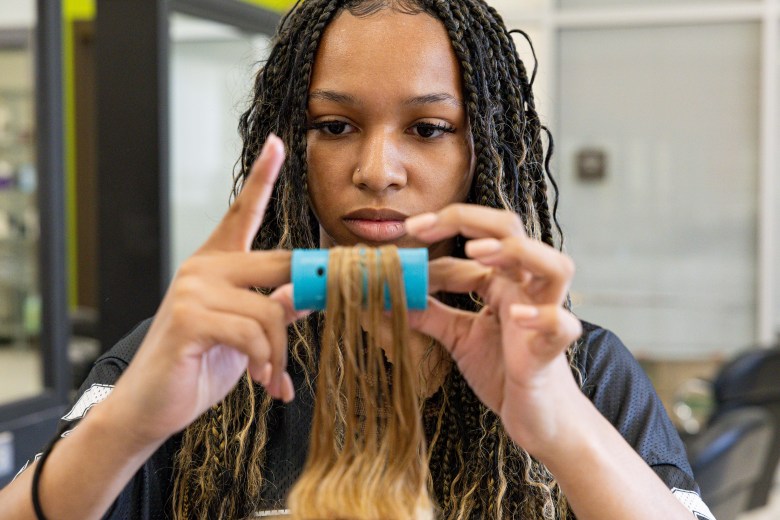 Sam Houston High School senior Aaliyah Williams, 17, works on hair curling techniques with rollers and pin curls during salon hours on Wednesday. Students earn practical hours for their time spent training in the salon working on mannequins and real-life clients. Credit: Amber Esparza / San Antonio Report
Sam Houston High School senior Aaliyah Williams, 17, works on hair curling techniques with rollers and pin curls during salon hours on Wednesday. Students earn practical hours for their time spent training in the salon working on mannequins and real-life clients. Credit: Amber Esparza / San Antonio Report
She spoke up every now and then, asking whether the pressure of the hand massage was good or whether the hot towels were comfortable. Sometimes she paused to ask her cosmetology teacher Monica Price a question.
There was no rush: salon days at Sam Houston last three class periods. Anyone can book appointments between 9 a.m. and 10:30 a.m. on Wednesdays, and services range from color treatments to haircuts and facials.
But that morning Williams struggled to find the right shade of maroon — a rush of clients since they reopened in September meant they quickly ran out of nail polish. Price said she had just put in an order for more shades, along with materials for gel and shellac treatments.
The program closed a few years ago due to declining enrollment at Sam Houston, but the community was very vocal about getting a cosmetology program back, said Johnny Vahalik, assistant superintendent of college, career and military readiness at SAISD.
“I like that we’re getting a lot more customers. It’s definitely helping us practice more and get more out there,” Williams said.
Looking past the license
Even as the Sam Houston cosmetology program competes with a growing number of Career and Technical Education offerings in SAISD, district officials say interest has remained steady and even grown as perception and business aspects of cosmetology changes.
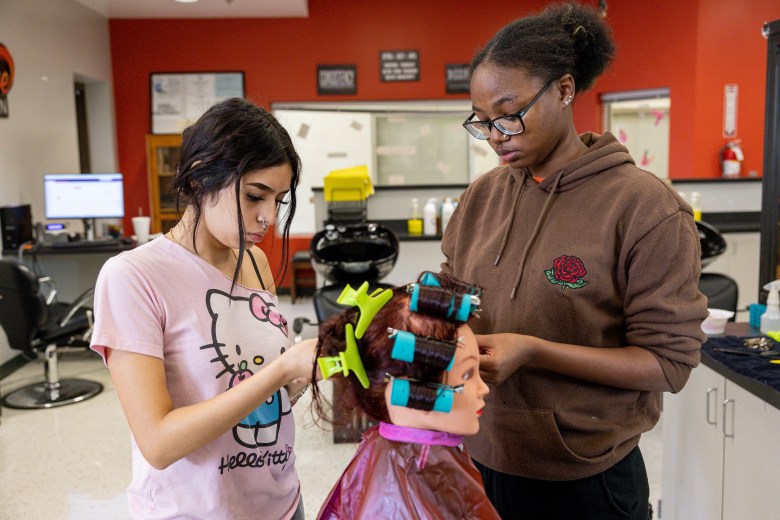 Sam Houston High School seniors Jareth Rodriguez and Khyola Harris work on hair curling techniques with rollers and a mannequin during salon hours on Wednesday. Credit: Amber Esparza / San Antonio Report
Sam Houston High School seniors Jareth Rodriguez and Khyola Harris work on hair curling techniques with rollers and a mannequin during salon hours on Wednesday. Credit: Amber Esparza / San Antonio Report
Cosmetology offerings used to be seen as “beauty school” for female students who didn’t have other options, said Konice Millender, CTE program coordinator at SAISD. But now there’s more interest in the program as a viable profession for everyone, and labor and pay studies don’t fully reflect how lucrative the industry can be.
“Once those kids pass the test, they’re going to get that license, and they’re going to walk right out of the high school’s door and into a career. There’s nothing in between,” Millender said.
Williams doesn’t plan on entering the cosmetic industry full-time, she said. But once she earns her license, she can also enter a fast-tracked associate degree pathway through Palo Alto. This program is open to anyone with a state license.
Williams plans to do nails while she attends veterinary school.
“All they’re having to do is take a few core classes and they’ve got their associates degree,” Vahalik said.
The school district’s program is in a way designed to feed into the Palo Alto program, Vahalik said. It is one of many ways that students can graduate high school with a license or certificate to immediately enter the workforce or as an accelerated pathway to higher education. Most times, students do both.
Palo Alto instructor Brenda Lopez says this option alone can make a huge difference for any practicing or licensed cosmetologist. About a decade ago, she paid about $13,000 in tuition to get her cosmetology license and later she invested another $4,000 for her teaching license.
After paying for equipment and materials out of pocket, she entered the workforce with debt.
“Coming to a community college to a private vocation school, it just doesn’t compare,” Lopez said. “You have the possibility of getting an associate here versus just going for the license… There’s more room for growth. I know not everybody stays in this field.”
The San Antonio Report partners with Open Campus on higher education coverage.

